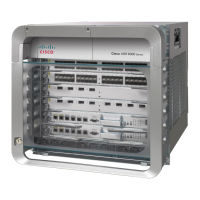15
Cisco ASR 9000 Series Aggregation Services Router Getting Started Guide
OL-28417-02
Introduction to the Cisco ASR 9000 Series Aggregation Services Router
Cisco ASR 9000 Series Router Overview
• Process restart—You can restart critical control-plane processes both manually and automatically in
response to a process failure versus restarting the entire operating system. This feature supports the
Cisco IOS XR Software goal of continuous system availability and allows for quick recovery from
process or protocol failures with minimal disruption to customers or traffic.
• State checkpoint—You can maintain a memory and critical operating state across process restarts to
sustain routing adjacencies and signaling state during a Route Switch Processor (RSP) switchover.
• Ethernet virtual connections (EVCs)—Ethernet services are supported using individual EVCs to
carry traffic belonging to a specific service type or end user through the network. You can use
EVC-based services in conjunction with MPLS-based L2VPNs and native IEEE bridging
deployments.
• Flexible VLAN classification—VLAN classification into Ethernet flow points (EFPs) includes
single-tagged VLANs, double-tagged VLANs (QinQ and IEEE 802.1ad), contiguous VLAN ranges,
and noncontiguous VLAN lists.
• IEEE Bridging—Software supports native bridging based on IEEE 802.1Q, IEEE 802.1ad, IEEE
802.1ah provider backbone bridges (PBB) and QinQ VLAN encapsulation mechanisms on the
router.
• IEEE 802.1s Multiple Spanning Tree (MST)—MST extends the IEEE 802.1w Rapid Spanning Tree
Protocol (MSTP) to multiple spanning trees, providing rapid convergence and load balancing.
• MST Access Gateway—This feature provides a resilient, fast-convergence mechanism for
aggregating and connecting to Ethernet-based access rings.
• Virtual Private LAN Services (VPLS)—VPLS is a class of VPN that supports the connection of
multiple sites in a single, bridged domain over a managed IP/MPLS network. It presents an Ethernet
interface to customers, simplifying the LAN and WAN boundary for service providers and
customers, and enabling rapid and flexible service provisioning because the service bandwidth is
not tied to the physical interface. All services in a VPLS appear to be on the same LAN, regardless
of location.
• Hierarchical VPLS (H-VPLS)—H-VPLS provides a level of hierarchy at the edge of the VPLS
network for increased scale. QinQ access and H-VPLS pseudowire access options are supported.
• Virtual Private WAN Services/Ethernet over MPLS (VPWS/EoMPLS)—EoMPLS transports
Ethernet frames across an MPLS core using pseudowires. Individual EFPs or an entire port can be
transported over the MPLS backbone using pseudowires to an egress interface or subinterface.
• Pseudowire redundancy—Pseudowire redundancy supports the definition of a backup pseudowire to
protect a primary pseudowire that fails.
• Multisegment pseudowire stitching—Multisegment pseudowire stitching is a method for
interworking two pseudowires together to form a cross-connect relationship.
• IPv4 Multicast—IPv4 Multicast supports Internet Group Management Protocol Versions 2 and 3
(IGMPv2/v3), Protocol Independent Multicast Source Specific Multicast (SSM) and Sparse Mode
(SM), Multicast Source Discovery Protocol (MSDP), and Anycast Rendezvous Point (RP).
• IGMP v2/v3 Snooping—This Layer 2 mechanism efficiently tracks multicast membership on an
L2VPN network. Individual IGMP joins are snooped at the VLAN level or pseudowire level, and
then it summarizes the results into a single upstream join message. In residential broadband
deployments, this feature enables the network to send only channels that are being watched to the
downstream users.
• NxDS0—This feature allows channelization of the Cisco 2-Port Channelized OC-12/DS0 SPA to
interface speeds as low as 56 kbit. To add bandwidth, you can combine channel groups/timeslots.
For more information on NxDS0, see Cisco ASR 9000 Series Aggregation Services Router Interface
and Hardware Component Configuration Guide.

